Wednesday, April 21, 2010
Build your Bike with BuildYourBicycle.com!
So I've started a new company, which teaches you to build your own bike. BuildYourBicycle.com - check it out!
Wednesday, November 25, 2009
Formal end of this blog, and start of a new one.
The more astute among you might have noticed that I stopped updating this blog some time ago (no shit, Al!).
I started writing this blog as a little diary of my new life in Barcelona, to let friends and family know what I was doing and what things were like out here.
However a year ago I realised that it had served its purpose. I was starting to write about another climbing trip, or another terrace party, or another skiing trip, and I realised that, basically, I nothing really interesting to say anymore!
So I stopped, and I think it was the right thing to do. A lot has happened since my last post, I got married, changed jobs, changed flat, got a cat, spent a month in Brazil etc., but I never really felt the need to write about it.
However now I've finally got back into my rock climbing in a serious way, and to motivate myself I've decided to start a new blog dedicated only to my rock-climbing. Apologies if you're not really interested in climbing, as it may not make much sense, it is written in climbing geek-speak. However, if you do want to go and check it out, the new address to remember is
http://www.8amyarse.com

Love you all,
Al
I started writing this blog as a little diary of my new life in Barcelona, to let friends and family know what I was doing and what things were like out here.
However a year ago I realised that it had served its purpose. I was starting to write about another climbing trip, or another terrace party, or another skiing trip, and I realised that, basically, I nothing really interesting to say anymore!
So I stopped, and I think it was the right thing to do. A lot has happened since my last post, I got married, changed jobs, changed flat, got a cat, spent a month in Brazil etc., but I never really felt the need to write about it.
However now I've finally got back into my rock climbing in a serious way, and to motivate myself I've decided to start a new blog dedicated only to my rock-climbing. Apologies if you're not really interested in climbing, as it may not make much sense, it is written in climbing geek-speak. However, if you do want to go and check it out, the new address to remember is
http://www.8amyarse.com

Love you all,
Al
Sunday, September 21, 2008
First climbing of the season
So finally the temperatures have dropped (to a pleasant 25ish degrees) which permits Spanish climbers to emerge, tanned but very weak from a couple of months sunbathing, from their summer hibernation (on the beach!). If you have been following the blog you'll know that over the summer I've done zero climbing, but in the last few weeks I realised that the climbing season was about to begin and I've been training again to get some fitness back, in anticipation of the first day back on rock.
Today was the perfect day for it, slightly overcast and with a light wind, though it's still September and that means still hunting the shade - climbing in the sun will still be too hot for another month or so at least. We drove 40 mins south from Barcelona to the Garraf national park. Those of you with particularly good memories will recall that this was the place where Djanira and I first went climbing after moving to Spain, about 18 months ago. Time flies and all that. Unfortunately Djanira was working today, so this time my companion was my Belgian pal (and fellow mountain biker, see last post) PJ. We visited a new sector, a place called Sectors Bombers (no panic, bombers means 'firemen' in Catalan) on the crag of Pic de Martell. While most of the routes on this crag are amenable trad routes of about 4 or 5 pitches, Sector Bombers is a very steep cave with a handful of harder sport routes. It's not very tall but the routes are about 20m long once you factor in the steepness, the view is unsurpassable and the routes are of excellent quality.
After warming up I managed to redpoint* a route graded 7a+, which is equal to my best efforts in sport climbing. Considering this is practically the first day of the season, I'm chuffed. I had kind of set myself the goal of redpointing 7c this season, but wasn't sure if it was too ambitious or not. The fact that I redpointed 7a+ in one day gives me a bit more confidence, but we'll see, it will require quite a bit of dedicated training. Still, it was a very good start to the season, and a good way to boost the confidence. Now where's that fingerboard...?
*non climbers note: redpoint is the term given to when you practice the route first i.e. climb a section, rest on the rope, work out the best sequence to do the moves, rest, climb, rest, climb, rest etc. until you reach the top. Then you come back down to the bottom and have a looong rest, before trying to climb the route in one go, without resting at all on the way. It's a very different style of climbing to the traditional 'onsight' approach, but it can also be very satisfying, as you end up climbing routes that at first seemed completely impossible. For more understanding see this.
Tuesday, September 16, 2008
Last riding of the season
On Saturday morning, PJ and I headed up to Andorra for one final weekend of riding this year. In actual fact the lifts are open for the next few weekends but this was the last opportunity that we have, now things like weddings take priority! Also, in July we had bought a "5 days for the price of 4" lift pass deal, which still had two days needing using up, so a perfect excuse - or at least it would have been, had PJ not forgotten to bring his tickets...!
Anyway the trails were in perfect nick, there was a very light periodic drizzle which kept the dirt moist and really grippy. Above is a moody shot, taken by PJ, (bigger) of me dropping in on a section of the MaxiAvalanche trail, which is several kilometers long and takes in a 500m drop in altitude. It was all great fun but now it's time to pack the bikes away and get the skis/boards out - there was already snow higher up the valley! I'll leave you with a couple more shots, one of PJ motoring downhill and one of a tired Alun setting the world to right in the gondola!
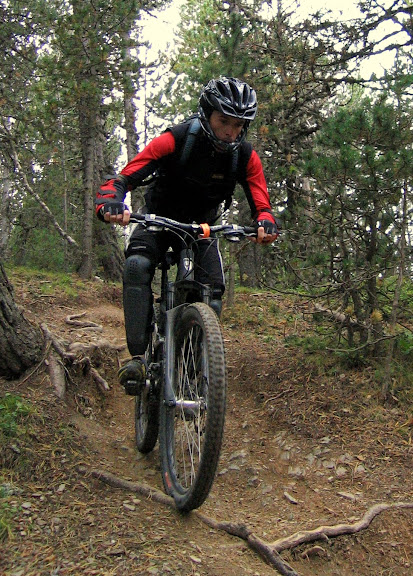
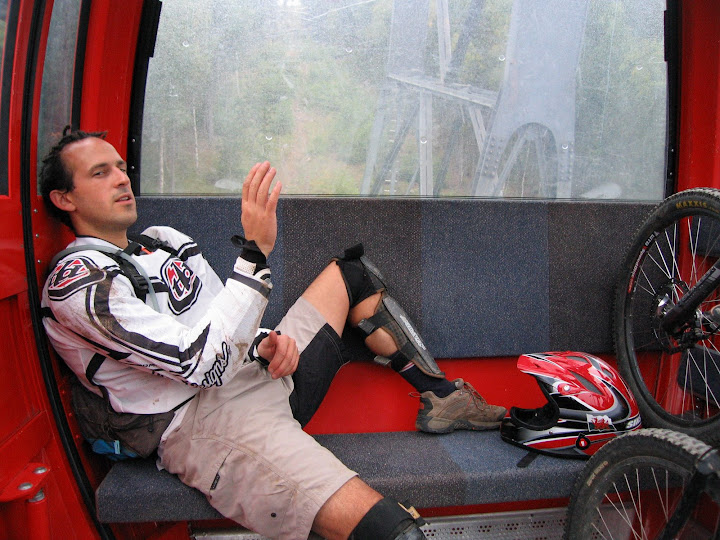
Anyway the trails were in perfect nick, there was a very light periodic drizzle which kept the dirt moist and really grippy. Above is a moody shot, taken by PJ, (bigger) of me dropping in on a section of the MaxiAvalanche trail, which is several kilometers long and takes in a 500m drop in altitude. It was all great fun but now it's time to pack the bikes away and get the skis/boards out - there was already snow higher up the valley! I'll leave you with a couple more shots, one of PJ motoring downhill and one of a tired Alun setting the world to right in the gondola!


Monday, September 08, 2008
5 steps to understanding why we need the LHC (or, Quantum Mechanics for Dummies)
The Large Hadron Collider (LHC) is about to be turned on this week, with the noble goal of recreating conditions as to how they were shortly after the Big Bang, in an attempt to find the Higgs boson. Brilliant!
The only problem is that if you are anything like me, you're probably wondering what the hell a Higgs boson is actually supposed to be. It sounds very exotic, but unfortunately the wikipedia page is full of unhelpful jargon, which I'm sure is technically all very correct, but fundamentally dull. As luck would have it I've just finished reading through a book called The Void, by Frank Close. It's a little heavier than your average popular science yarn, but it does a pretty good job of explaining a few mysteries. So, as much for my benefit as anybody elses, I thought I'd try to summarise my understanding. If any clever physicist type people happen to read this, and think it's all tosh and I've explained it rubbishly, then do please let me know.
To understand what the Higgs boson is supposed to be, and more importantly where it's supposed to come from, we need to have a little background in quantum mechanics. Quantum mechanics is famous for having lots of wierd bits to it. So I'm going to structure the argument around those.
Weird Bit #1: The Heisenberg uncertainty principal is probably the least weird bit of quantum mechanics. It basically says that you can either know a thing's exact location, or you can know its precise speed, but you can't know both at the same time. This kind of makes sense - as even the act of measuring something's location will change its location, because your measuring tool will move it slightly (even beams of light have energy which can 'move' things). The weirdest part is that, if you know something's location exactly, then it must be moving (if it wasn't, both relative location and energy (speed) would be zero, which violates the principle). Given that the act of measuring something's location inherently moves it somehow, the only way we can be 100% sure of something's location is to remove it i.e. create a vacuum. In a vacuum we know, with all certainty, that there is nothing there!
Weird Bit #2: Zero point energy is the name given to the consequence of Weird Bit 1. If we create a vacuum in a room, we know the exact location of things inside it (i.e. they don't exist!). The uncertainty principle means that therefore there must be some energy in the vacuum. This is Weird Bit #2 and I'm you'll agree that it is exceptionally weird. But I'm afraid that it is a fact, verified experimentally. We just have to accept that a vacuum is filled with a level of background energy - a very very very low level, but there all the same. The technical term for this is zero point energy - i.e. the lowest possible energy state that can exist.
Weird Bit #3: Virtual electrons and positrons. We all know that -1 and +1, when added together, equal zero. A positive counters a negative. That's logical. Well, think of it from the other side and then it follows that 0 = (+1) + (-1) i.e. by reversing the addition process you can end up with something positive and something negative. In physics and chemistry, 'negative' is frequently represented by an electron, which is essentially a negative charge which has a very very small mass. Its positive equivalent is the positron (which isn't so famous, as it doesn't really have much of a role in standard chemistry. It's basically the mirror image of an electron, and has a positive charge). Weird bit #3 is that fluctuations in the zero point energy field can occasionally reach levels high enough where they reverse the equation above i.e. zero changes into an electron (-1) and a positron (+1). Technically, the electron and positron existed as 'virtual' particles, and the energy fluctuation became high enough to turn them into 'real' particles. Unfortunately for our newly born electron and positron, it is impossible for anything to exist in the same place at the same time, so they very (very) quickly disappear (i.e. +1 and -1 equal zero again). This seems exceptionally weird, but it has been proven - the current particle accelerator at CERN manages to achieve such high energy levels, by smashing things together at such speed, that it manages to push apart newly born protons and electrons before they disappear - literally generating something out of nothing.
Weird Bit #4: The Higgs field. Weird Bits 1-3 were important as background, but this is where it really starts. One of the biggest questions that faces science is: what are we made of? i.e. what is mass? Physicist Peter Higgs has proposed that mass is the result of everything's interaction with an all permeating field, which has become to be known as the Higgs field. You can think of it as the fabric of the universe - a human, a protein, a molecule, an atom, a proton, an electron, a quark and everything only exists as it is due to the way it interacts with this all-encompassing field. The problem with the Higgs field is that, right now, it is just a theory. There's lots of theoretical evidence for it, but unlike Weird Bits 1-3, as yet there is no practical proof. Which leads us finally to…
Weird Bit #5: The Higgs boson. If the Heisenberg uncertainty principle (Weird bit 1) applies to the Higgs field, then Weird bits 2 and 3 should also apply i.e. there should be a zero point energy level in the field, and some form of virtual particles popping in an out of existence (the situation is much more complex than this, but this is currently the limit of my understanding!). The name given to this hypothetical virtual particle is the Higgs boson. The only problem is, that the equations that result from Higgs' theories suggest that, to even stand a chance of creating a Higgs boson, we'd need a colossal amount of energy.
The LHC is designed to be able to create such an amount of energy. It will accelerate protons around a 27km wide ring until they are at almost the speed of light, and then let them collide head on. This collision will generate vast levels of energy - enough that if a virtual Higgs boson decides to pop into existence at the right time, it will sent flying by the collision, and detected by the surrounding detectors, before it has time to disappear. This would then prove Higgs' theory, and give us concrete evidence of the very fabric of the universe. I think.
Phew!
N.B. Of course, I should point out that this is just one of the problems the LHC will look at. To find out about some of the others, check out the British LHC page.
Update: The Grauniad has a simple but good interactive guide.
The only problem is that if you are anything like me, you're probably wondering what the hell a Higgs boson is actually supposed to be. It sounds very exotic, but unfortunately the wikipedia page is full of unhelpful jargon, which I'm sure is technically all very correct, but fundamentally dull. As luck would have it I've just finished reading through a book called The Void, by Frank Close. It's a little heavier than your average popular science yarn, but it does a pretty good job of explaining a few mysteries. So, as much for my benefit as anybody elses, I thought I'd try to summarise my understanding. If any clever physicist type people happen to read this, and think it's all tosh and I've explained it rubbishly, then do please let me know.
To understand what the Higgs boson is supposed to be, and more importantly where it's supposed to come from, we need to have a little background in quantum mechanics. Quantum mechanics is famous for having lots of wierd bits to it. So I'm going to structure the argument around those.
Weird Bit #1: The Heisenberg uncertainty principal is probably the least weird bit of quantum mechanics. It basically says that you can either know a thing's exact location, or you can know its precise speed, but you can't know both at the same time. This kind of makes sense - as even the act of measuring something's location will change its location, because your measuring tool will move it slightly (even beams of light have energy which can 'move' things). The weirdest part is that, if you know something's location exactly, then it must be moving (if it wasn't, both relative location and energy (speed) would be zero, which violates the principle). Given that the act of measuring something's location inherently moves it somehow, the only way we can be 100% sure of something's location is to remove it i.e. create a vacuum. In a vacuum we know, with all certainty, that there is nothing there!
Weird Bit #2: Zero point energy is the name given to the consequence of Weird Bit 1. If we create a vacuum in a room, we know the exact location of things inside it (i.e. they don't exist!). The uncertainty principle means that therefore there must be some energy in the vacuum. This is Weird Bit #2 and I'm you'll agree that it is exceptionally weird. But I'm afraid that it is a fact, verified experimentally. We just have to accept that a vacuum is filled with a level of background energy - a very very very low level, but there all the same. The technical term for this is zero point energy - i.e. the lowest possible energy state that can exist.
Weird Bit #3: Virtual electrons and positrons. We all know that -1 and +1, when added together, equal zero. A positive counters a negative. That's logical. Well, think of it from the other side and then it follows that 0 = (+1) + (-1) i.e. by reversing the addition process you can end up with something positive and something negative. In physics and chemistry, 'negative' is frequently represented by an electron, which is essentially a negative charge which has a very very small mass. Its positive equivalent is the positron (which isn't so famous, as it doesn't really have much of a role in standard chemistry. It's basically the mirror image of an electron, and has a positive charge). Weird bit #3 is that fluctuations in the zero point energy field can occasionally reach levels high enough where they reverse the equation above i.e. zero changes into an electron (-1) and a positron (+1). Technically, the electron and positron existed as 'virtual' particles, and the energy fluctuation became high enough to turn them into 'real' particles. Unfortunately for our newly born electron and positron, it is impossible for anything to exist in the same place at the same time, so they very (very) quickly disappear (i.e. +1 and -1 equal zero again). This seems exceptionally weird, but it has been proven - the current particle accelerator at CERN manages to achieve such high energy levels, by smashing things together at such speed, that it manages to push apart newly born protons and electrons before they disappear - literally generating something out of nothing.
Weird Bit #4: The Higgs field. Weird Bits 1-3 were important as background, but this is where it really starts. One of the biggest questions that faces science is: what are we made of? i.e. what is mass? Physicist Peter Higgs has proposed that mass is the result of everything's interaction with an all permeating field, which has become to be known as the Higgs field. You can think of it as the fabric of the universe - a human, a protein, a molecule, an atom, a proton, an electron, a quark and everything only exists as it is due to the way it interacts with this all-encompassing field. The problem with the Higgs field is that, right now, it is just a theory. There's lots of theoretical evidence for it, but unlike Weird Bits 1-3, as yet there is no practical proof. Which leads us finally to…
Weird Bit #5: The Higgs boson. If the Heisenberg uncertainty principle (Weird bit 1) applies to the Higgs field, then Weird bits 2 and 3 should also apply i.e. there should be a zero point energy level in the field, and some form of virtual particles popping in an out of existence (the situation is much more complex than this, but this is currently the limit of my understanding!). The name given to this hypothetical virtual particle is the Higgs boson. The only problem is, that the equations that result from Higgs' theories suggest that, to even stand a chance of creating a Higgs boson, we'd need a colossal amount of energy.
The LHC is designed to be able to create such an amount of energy. It will accelerate protons around a 27km wide ring until they are at almost the speed of light, and then let them collide head on. This collision will generate vast levels of energy - enough that if a virtual Higgs boson decides to pop into existence at the right time, it will sent flying by the collision, and detected by the surrounding detectors, before it has time to disappear. This would then prove Higgs' theory, and give us concrete evidence of the very fabric of the universe. I think.
Phew!
N.B. Of course, I should point out that this is just one of the problems the LHC will look at. To find out about some of the others, check out the British LHC page.
Update: The Grauniad has a simple but good interactive guide.
Thursday, August 28, 2008
More Flashdance pics
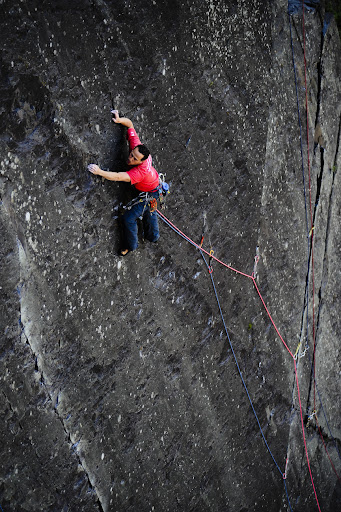
Flashdance is the trad highpoint of my climbing career so far, and as it was during the BMC International Meet, I was lucky enough to have professional climbing photographer Alex Messenger snapping away at the time, so here are a few images that he took of the moment.

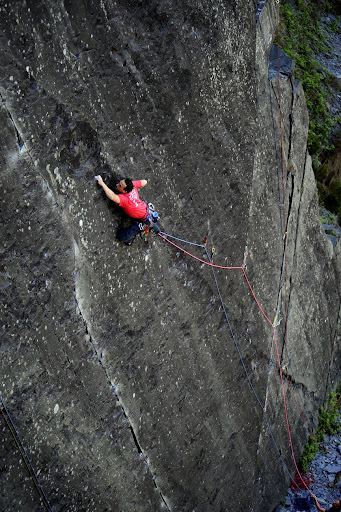
On the same day he also took a spectacular photo of Jo on Cystisis by Proxy. Such determination!
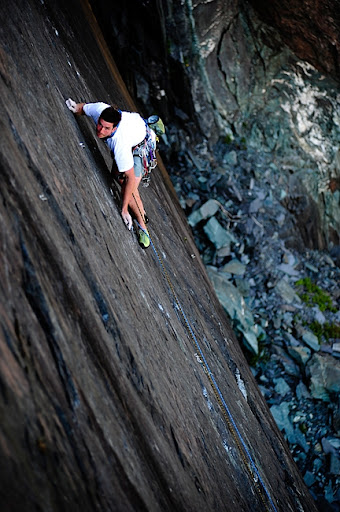 Incidently, these photos were taken in the very same quarries we went for a wander around on my stag do.
Incidently, these photos were taken in the very same quarries we went for a wander around on my stag do.All photos copyright Alex Messenger, 2008.
Wednesday, August 27, 2008
Braid
The basic engine of the game is a hark back to classic 2D platformers of the 80s, such as Super Mario World or similar, in which the controllable character (named 'Tim' here) runs backwards and forwards, climbs up and down ladders, and kills enemies by jumping on their heads. So far, so familiar. The crucial difference is that you, as the player, have the ability to reverse time - by holding down a button on your controller, you can rewind everything that has passed since you started each level. What makes it really interesting is that each area of the game introduces different time-bending properties e.g. objects glowing green are immune to your time-reversal powers, and occasionally you can deploy a ring that slows down time in a decreasingly powerful radius surrounding it. In one world time is stationary, but every step you take to the right advances it, and every step to the left reverses it. It turns the game into less of a standard platformer (after all, there is no concept of death or 'lives' - you just reverse time!) and more into a puzzle game, where you have to manipulate switches, platforms, keys, doors and other characters through time.
It is both visually beautiful and thoroughly engrossing to play through, but an extra twist is the story. Presented to you rather basically as a series of short sections of text that flit up on the screen, at first read through it appears that it is a load of sentimental tosh about rescuing a Princess (a la Mario). But upon reaching the end of the final level, you realise there is a darker theme that has been running through the game. A bit of thinking (and background reading) and it becomes clear that the whole thing is an allagory for the development of the nuclear bomb, and of scientists' desire to pursue research, even when it yields such destructive power. Tim, depicted as a rather bland hero, with a mop of unruly hair, shabby suit and red tie, is a scientist researching the bomb, pushing others away from him in his quest, fearful of the outcome, but unable to stop driving himself towards it.
"Now we are all sons of bitches" was the legendary remark made by Kenneth Thomas Bainbridge as he congratulated Oppenheimer and others after they succesfully tested the first nuclear bomb in the American desert. The story of Braid both pays homage and criticises those scientists, wrapping it up into a short yet addictive platform puzzler. Like a good book or film, this is something I'll be fetching down from the (metaphorical) shelf for several years to come.
Subscribe to:
Comments (Atom)



